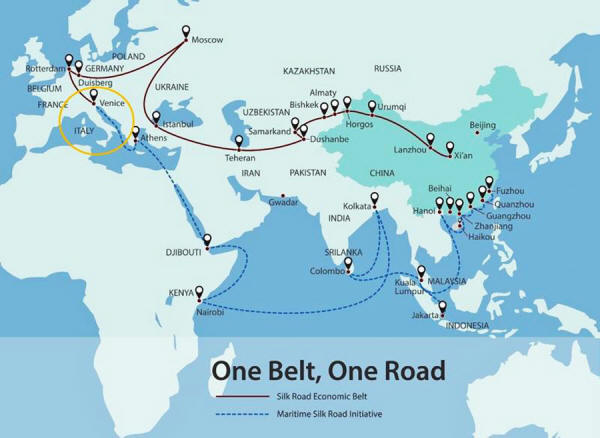|

by Federico Pieraccini
April
08, 2019
from
TechnocracyNews Website

As a Technocracy, China is driven to create
infrastructure and develop the global supply chain,
both of which are central to its
Belt and Road initiative.
Europe is playing both sides of the fence with
America on one hand, and China on the other.
TN Editor
The multipolar transformation that is occurring across the Eurasian
continent confirms the industrial and diplomatic cooperation between
China and the European continent in spite of strong opposition from
the United States.
Xi Jinping's visit to Europe confirms what many of us have
been writing about over the past few months and years, namely, the
reality of an ongoing global transformation of a 'world
dominated' by the United States to a pluralistic one
composed of different powers collectively shaping a multipolar
world.
Europe therefore finds itself in fortuitous position, balanced as it
is between its old world links to
the United States on the one side
and the fledgling Eurasian one being ushered in by
Russia and
China on the other.
Countries like Germany and France, but even the United Kingdom, have
long implemented commercial policies that encourage integration
between the countries of the Eurasian supercontinent.
In 2015, the United
Kingdom was among the first Western countries to join the Chinese
Asian Infrastructure Investment Bank (AIIB),
which finances projects of the Belt and Road Initiative (BRI).

The Chinese BRI mega project kicked off in 2014 with the ambitious
goal of integrating trade between China and Europe by sea and by
land, in the process incorporating all the countries in between.
The idea, as a natural
consolidation of trade, is to shorten the delivery times of goods by
rail and integrate sea routes.
The project covers not
only ports and rail lines but also the construction of technological
infrastructure to achieve global interconnectivity using the
5G technology developed by the
Chinese tech giant Huawei.
Germany and France have over the years deepened their partnerships
with Beijing.
Paris in particular
boasts historical ties with China stemming from the nuclear
cooperation between China General Nuclear Power Group (CGNPC)
and Électricité de France (EDF) stretching back to 1978, as
well as the aerospace one between Airbus and the Chinese aviation
companies that has been ongoing since 1985.
Italy has in recent months approached the BRI as a result of the new
government consisting of the
Lega Nord and Five Star
Movement (M5S).
The decision to
sign a memorandum of understanding
between Beijing and Rome underlines how the new government wants to
maintain a balanced position between Washington and Beijing in
certain sectors.
This is exactly the
approach of Germany, which has elected to continue deepening its
ties with Moscow vis-a-vis hydrocarbons and
Nord Stream 2 in the face of
pressure from Washington.
Moreover, both Germany
and Italy have confirmed that they want to rely on Huawei for the
implementation and management of 5G traffic, which is fundamental to
a world dominated by the internet of things.
The decisions of Germany, France and Italy
to continue their cooperation with Moscow and Beijing in various
fields, flies in the face of the narrative advanced by the
American-controlled 'scaremongering'
media controlled that attempts
to discourage European politicians from acting in the interests of
their countries and engaging with Russia and China...
|



